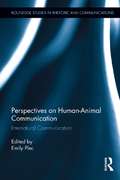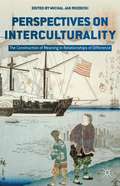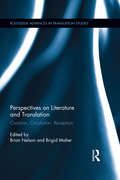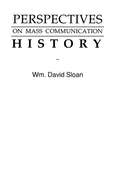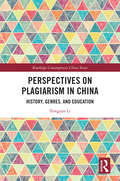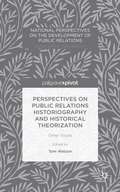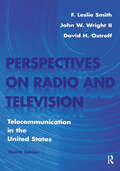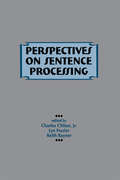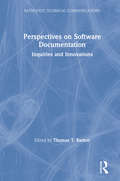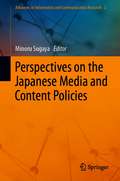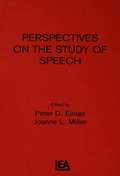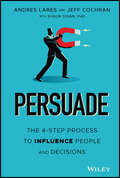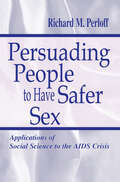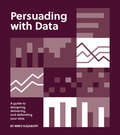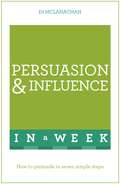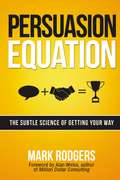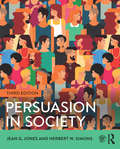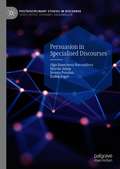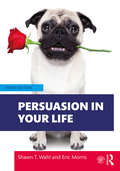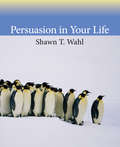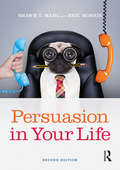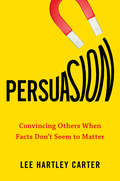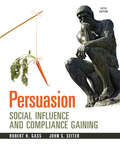- Table View
- List View
Perspectives on Human-Animal Communication: Internatural Communication (Routledge Studies in Rhetoric and Communication)
by Emily PlecDespite its inherent interdisciplinarity, the Communication discipline has remained an almost entirely anthropocentric enterprise. This book represents early and prominent forays into the subject of human-animal communication from a Communication Studies perspective, an effort that brings a discipline too long defined by that fallacy of division, human or nonhuman, into conversation with animal studies, biosemiotics, and environmental communication, as well as other recent intellectual and activist movements for reconceptualizing relationships and interactions in the biosphere. This book is a much-needed point of entry for future scholarship on animal-human communication, as well as the whole range of communication possibilities among the more-than-human world. It offers a groundbreaking transformation of higher education by charting new directions for communication research, policy formation, and personal and professional practices involving animals.
Perspectives on Interculturality
by Michal Jan RozbickiThe intercultural occurs in the space between two or more distinct cultures that encounter each other, an area where meaning is translated and difference is negotiated. A better, more systemic understanding of these processes is a major challenge of our time. Intercultural themes have thus far been mostly pursued within bounded academic disciplines, but the fact that people often have multiple, overlapping cultural affinities, and that cultures are inherently dynamic because they are man-made, not fixed and ahistorical systems, begs for interdisciplinary approaches. However, scholars are rarely trained to do so. They are routinely constrained by conventionalized conceptual languages of their disciplines, by their own apperceptions and assumptions, and by the incommensurability of frameworks of knowledge in an increasingly interconnected world. Intercultural studies are due for reflection and refinement. This volume brings together international scholars from diverse disciplines to reflect on the phenomenon of interculturality, and to share the theoretical and methodological frameworks of interpreting it.
Perspectives on Literature and Translation: Creation, Circulation, Reception (Routledge Advances in Translation and Interpreting Studies #5)
by Brian Nelson Brigid MaherThis volume explores the relationship between literature and translation from three perspectives: the creative dimensions of the translation process; the way texts circulate between languages; and the way texts are received in translation by new audiences. The distinctiveness of the volume lies in the fact that it considers these fundamental aspects of literary translation together and in terms of their interconnections. Contributors examine a wide variety of texts, including world classics, poetry, genre fiction, transnational literature, and life writing from around the world. Both theoretical and empirical issues are covered, with some contributors approaching the topic as practitioners of literary translation, and others writing from within the academy.
Perspectives on Mass Communication History (Routledge Communication Series)
by Wm. David SloanThis unique volume is based on the philosophy that the teaching of history should emphasize critical thinking and attempt to involve the student intellectually, rather than simply provide names, dates, and places to memorize. The book approaches history not as a cut-and-dried recitation of a collection of facts but as multifaceted discipline. In examining the various perspectives historians have provided, the author brings a vitality to the study of history that students normally do not gain. The text is comprised of 24 historiographical essays, each of which discusses the major interpretations of a significant topic in mass communication history. Students are challenged to evaluate each approach critically and to develop their own explanations. As a textbook designed specifically for use in graduate level communication history courses, it should serve as a stimulating pedagogical tool.
Perspectives on Plagiarism in China: History, Genres, and Education (ISSN)
by Yongyan LiThis book examines the issue of plagiarism in the Chinese context of history and education, both in classical and contemporary times.In view of the effort on a global scale to fight against plagiarism and consolidating anti-plagiarism education, this book examines how plagiarism is conceptualized and addressed in the Confucian Heritage Culture society of China. Employing qualitative content analysis, genre analysis, and discourse analysis to examine Chinesemedium textual materials of different kinds, this book offers new perspectives on the question of plagiarism in China. These textual materials include classic and ancient Chinese books, modern newspapers in China (1840–1949), academic literature, correspondence texts on plagiarism cases, and textbooks published in China on Chinese and English academic writing.Inspiring future research and educational initiatives aimed at addressing the problem of plagiarism in the contemporary world, this book will appeal to students and scholars of education, Chinese history, and Asian studies.
Perspectives on Public Relations Historiography and Historical Theorization: Other Voices
by Tom WatsonThe National Perspectives on the Development of Public Relations: Other Voices series is the first to offer an authentic world-wide view of the history of public relations. It will feature six books, five of which will cover continental and regional groups. This last book in the series focuses on historiographical and theoretical approaches.
Perspectives on Radio and Television: Telecommunication in the United States
by John W. Wright F. Leslie Smith David H. OstroffThis textbook describes the field of radio and television in the United States, presents the material in a manner the reader can grasp and enjoy, and makes the book useful for the classroom teacher. Written for adaptation to individual teaching situations, the book is divided by subject matter into logical chapter divisions that can be assigned in the order appropriate for specific course students. Each chapter stands by itself, but the book is also an integrated whole. It is easy to understand at first reading, by beginning radio-television majors or nonmajor elective students alike. To give readers a complete picture of the field, subjects such as ethics, careers, and rivals to U.S. commercial radio and television are included.
Perspectives on Sentence Processing
by Keith Rayner Charles Clifton Lyn FrazierOne of the liveliest forums for sharing psychological, linguistic, philosophical, and computer science perspectives on psycholinguistics has been the annual meeting of the CUNY Sentence Processing Conference. Documenting the state of the art in several important approaches to sentence processing, this volume consists of selected papers that had been presented at the Sixth CUNY Conference. The editors not only present the main themes that ran through the conference but also honor the breadth of the presentations from disciplines including linguistics, experimental psychology, and computer science. The variety of sentence processing topics examined includes: * how evoked brain potentials reflect sentence comprehension * how auditory words are processed * how various sources of grammatical and nongrammatical information are coordinated and used * how sentence processing and language acquisition might be related. This distinctive volume not only presents the most exciting current work in sentence processing, but also places this research into the broader context of theorizing about it.
Perspectives on Software Documentation: Inquiries and Innovations (Baywood's Technical Communications)
by Thomas T BarkerThis book is designed to address the randomness of the literature on software documentation. As anyone interested in software documentation is aware, the field is highly synthetic; information about software documentation may be found in engineering, computer science training, technical communication, management, education and so on. "Perspectives on Software Documentation" contains a variety of perspectives, all tied together by the shared need to make software products more usable.
Perspectives on the Japanese Media and Content Policies (Advances in Information and Communication Research #2)
by Minoru SugayaThis book offers a comprehensive overview of Japan’s media policies. In light of the attention Japanese media content has attracted in recent years, not only in Japan but also overseas, the book examines the media industry that supports such content. Beginning with the traditional terrestrial broadcasting industry, it also covers cable TV, satellite broadcasting, and over-the-top media services (OTT), as well as media policies for film, animation, games and music.The Ministry of Internal Affairs and Communications (MIC), a key media industry regulator in Japan, has been developing broadcasting policies for more than 70 years, and while their traditional policies have not changed in principle, the scope of their business sphere has expanded. For instance, major broadcasting stations in Tokyo, known as key stations, have played an important role in filmmaking with the big four film companies, and have started joint ventures with major OTT, such as Hulu.This book allows readers to gain a comprehensive understanding of the changes in the Japanese media industry in general and the related policies in Japan, while also offering insights into developments in the individual sectors.
Perspectives on the Study of Speech
by Peter D. Eimas, Joanne L. MillerPublished in the year 1982, Perspectives on the Study of Speech is a valuable contribution to the field of Cognitive Psychology.
Persuade: The 4-Step Process to Influence People and Decisions
by Jeff Cochran Andres Lares Shaun DiganTransform your ability to persuade and negotiate with this practical new resource In Persuade: The 4-Step Process to Influence People and Decisions, accomplished sales, negotiation, and influence experts Andres Lares, Jeff Cochran, and Shaun Digan PhD deliver a concise and insightful take on how to transform your ability to persuade others regardless of the setting. In this important book you'll discover: Original research and scientific studies shedding light on the human decision-making processes that drive success and failure in virtually all interactions Real world examples and practical exercises to illustrate and practice the concepts discussed A fun yet rigorous approach of a complex subject that can be practically applied in any business situation Persuade is perfect for executives, managers, entrepreneurs, and other business leaders and will earn a place in the libraries of any professional who negotiates or influences on a regular basis. It is an invaluable resource for anyone seeking to improve their persuasion or deal-making abilities.
Persuading People To Have Safer Sex: Applications of Social Science To the Aids Crisis (Routledge Communication Series)
by Richard M. PerloffPersuading People to Have Safer Sex offers a lucid, in-depth, student-friendly and academically thorough discussion of AIDS prevention and health persuasion. In so doing it provides an introduction to the ways that social scientific research can be brought to bear on a daunting health problem. Covering many aspects of the AIDS crisis, the book introduces readers to the severity of the AIDS problem and explains the epidemiology of the disease. It discusses why persuasion is so important, explicates cognitive theories of AIDS prevention, and notes the role emotions and communication play in safer sex prevention. It also discusses: *functions that unsafe sex plays in peoples' lives; *why people, notably minority women, frequently choose to engage in unsafe sex; and *social factors underlying the spread of AIDS in urban America and portions of Africa. As a resource for introducing students to the role that theory and research play in health communication and psychology, the volume is appropriate for use in communication, journalism, social psychology, and public health courses, and will be of value to scholars, researchers, and all who seek to understand the use of persuasion in changing behavior.
Persuading with Data: A Guide to Designing, Delivering, and Defending Your Data
by Miro KazakoffAn integrated introduction to data visualization, strategic communication, and delivery best practices.Persuading with Data provides an integrated instructional guide to data visualization, strategic communication, and delivery best practices. Most books on data visualization focus on creating good graphs. This is the first book that combines both explanatory visualization and communication strategy, showing how to use visuals to create effective communications that convince an audience to accept and act on the data. In four parts that proceed from micro to macro, the book explains how our brains make sense of graphs; how to design effective graphs and slides that support your ideas; how to organize those ideas into a compelling presentation; and how to deliver and defend data to an audience. Persuading with Data is for anyone who has to explain analytical results to others. It synthesizes a wide range of skills needed by modern data professionals, providing a complete toolkit for creating effective business communications. Readers will learn how to simplify in order to amplify, how to communicate data analysis, how to prepare for audience resistance, and much more. The book integrates practitioner and academic perspectives with real-world examples from a variety of industries, organizations, and disciplines. It is accessible to a wide range of readers—from undergraduates to mid-career and executive-level professionals—and has been tested in settings that include academic classes and workplace training sessions.
Persuasion And Influence In A Week: How To Persuade In Seven Simple Steps
by Di McLanachanSundayExplore factors that influence, both positively and negatively and discover how influencing is selling MondayUnderstand the power of personality and charisma and ensure you are putting the right message acrossTuesdayUse the Assertiveness Sentence technique to sound more confident in any situationWednesdayDiscover the three elements of communication and how to use them to build rapid, effective rapport with othersThursdayLearn to recognize the internal filters that we all have and utilize them in patterns of persuasionFridayUse NLP models to influence at an unconscious level, including the technique of 'chunking' to gain agreement SaturdayLearn how to use proven persuasion techniques such as emotional 'triggers', scarcity, the law of reciprocity, the power of three, and the AIDA formula
Persuasion And Influence In A Week: How To Persuade In Seven Simple Steps
by Di MclanachanSundayExplore factors that influence, both positively and negatively and discover how influencing is selling MondayUnderstand the power of personality and charisma and ensure you are putting the right message acrossTuesdayUse the Assertiveness Sentence technique to sound more confident in any situationWednesdayDiscover the three elements of communication and how to use them to build rapid, effective rapport with othersThursdayLearn to recognize the internal filters that we all have and utilize them in patterns of persuasionFridayUse NLP models to influence at an unconscious level, including the technique of 'chunking' to gain agreement SaturdayLearn how to use proven persuasion techniques such as emotional 'triggers', scarcity, the law of reciprocity, the power of three, and the AIDA formula
Persuasion Equation: The Subtle Science of Getting Your Way
by Alan Weiss Mark RodgersHow do you get people to see things your way? Whether you're trying to secure a promotion, make a sale, or rally support for a new idea, the ability to persuade those around you is absolutely essential to success. Merging research and real-world application, this insightful guide reveals what really drives decisions and introduces readers to the persuasion equation--a powerful combination of factors proven to speed agreement. Readers will discover the surprising reasons people say "yes" and learn how to: Radiate an aura of expertise * Win trust and leverage credibility * Build a business case that appeals to both heart and mind * Adapt for personality, gender, and generational differences * Use language strategically * Perfect the five-step persuasion process * Generate group buy-in * Master organizational politics * And more From crafting compelling emails to convincing a colleague to nailing the big presentation, Persuasion Equation is your personal recipe for success.
Persuasion in Society: 3rd Edition
by Jean G. Jones Herbert W. SimonsPersuasion in Society, Third Edition introduces readers to the rich tapestry of persuasive technique and scholarship, interweaving rhetorical, critical theory, and social science traditions. This text examines current and classical theory through the lens of contemporary culture, encouraging readers to explore the nature of persuasion and to understand its impact in their lives. Employing a contemporary approach, authors Jean G. Jones and Herbert W. Simons draw from popular culture, mass media, and social media to help readers become informed creators and consumers of persuasive messages. This introductory persuasion text offers: A broad-based approach to the scope of persuasion, expanding students’ understanding of what persuasion is and how it is effected. Insights on the diversity of persuasion in action, through such contexts as advertising, marketing, political campaigns, activism and social movements, and negotiation in social conflicts. The inclusion of "sender" and "receiver" perspectives, enhancing understanding of persuasion in practice. Extended treatment of the ethics of persuasion, featuring opposing views on handling controversial issues in the college classroom for enhanced instruction. Case studies showing how and why people fall for persuasive messages, demonstrating how persuasion works at a cognitive level. Discussion questions, exercises, and key terms for very nearly every chapter. The core of this book is that persuasion is about winning beliefs and not arguments and that communicators who want to win that belief need to communicate with their audiences. This new edition of Persuasion in Society continues to bring this core message to readers with updated case studies, examples, and sources.
Persuasion in Specialised Discourses (Postdisciplinary Studies in Discourse)
by Olga Dontcheva-Navratilova Martin Adam Renata Povolná Radek VogelThis book examines the concept of persuasion in written texts for specialist audiences in the English and Czech languages. By exploring a corpus of academic research articles, corporate reports, religious sermons and user manuals the authors aim to reveal similarities and differences in rhetorical strategies across cultures and genres. They draw on Biber and Conrad’s (2009) model for contextualising interaction in specialised discourses, Bell’s (1997) framework for the analysis of participants roles, Swales’ (1990) genre analysis approach for considering genre constraints and Hyland’s (2005) metadiscourse model for investigating writer-reader interaction. The result is a book which will appeal to researchers and students in Discourse Studies, especially those with an interest in genre and rhetorical strategies.
Persuasion in Your Life
by Eric Morris Shawn T. WahlThis accessible introductory textbook in persuasive communication speaks directly to the student by focusing on real-life experiences in personal, social, and professional contexts. Through its use of rhetoric, criticism, and social scientific research, this book helps readers understand, analyze, and use persuasion in their lives and careers. It explores techniques of verbal and visual persuasion for use in business and professional communication, health communication, and everyday life, as well as expanded coverage of persuasion in social movements and social advocacy. It also pays attention throughout to ethical considerations and to the significance of new media. This textbook is a student-friendly introduction suitable for use in undergraduate courses in persuasion, health communication, and business communication. The companion website includes an instructor’s manual with test questions, sample assignments, web links, and other resources, as well as PowerPoint slides. Visit www.routledge.com/wahl
Persuasion in Your Life
by Shawn WahlPersuasion in Your Life speaks directly to the student by focusing on actual life experiences–from critically viewing persuasive public campaigns to making business and health care decisions. The book reflects a balance of theory and application and draws material from communication, psychology, and other disciplines. Through its use of rhetoric, criticism, and social scientific research, the book helps readers understand, analyze, and use persuasion in their life and career.
Persuasion in Your Life (Second Edition)
by Eric Morris Shawn T. WahlPersuasion in Your Life, 2nd Edition speaks directly to the student by focusing on real-life experiences, from critically viewing persuasive public campaigns to making business and health care decisions. This new edition concludes with a new chapter on the assessment of persuasive messages. It also features new chapter-opening vignettes that immediately apply concepts to daily life, as well as "What You’ve Learned" reviews for comprehension. Students and instructors can use the wealth of online resources that accompany this text, including an instructor manual, Power Point slides, test questions, and more. Through its use of rhetoric, criticism, and social scientific research, this book helps readers understand, analyze, and use persuasion in their life and career.
Persuasion: Convincing Others When Facts Don't Seem to Matter
by Lee Hartley CarterThe secrets to persuading anyone, at work and in life, from a top communication strategist.In the post-fact, deeply divided world we live in, true persuasion is rare. Engaging with people holding differing opinions is rarer still. But for progress to take place, persuasion must happen. Whether it's convincing an employer you are right for the job, a customer that your product is the best, or your closed-minded uncle that good people can disagree, it takes the art--and science--of persuasion to move forward.So, how do you change someone's mind--or at least advance the conversation--when everyone is entrenched in their own points of view? Communication expert Lee Hartley Carter has spent nearly twenty years advising and helping the world's most well-known companies do just that.Among the counterintuitive secrets you'll learn: * It's not enough to understand the person you're talking to--you must truly empathize with them (yes, even them). * Logic alone doesn't work. Stories and emotions are what move us most. * When communicating in a crisis, our first instinct is almost always wrong.Filled with deeply researched insights into how we make up--and change--our minds, as well as colorful real-world examples and actionable recommendations, Persuasion will help you hone your message and craft your narrative in order to get heard and get results.
Persuasion: Social Inflence and Compliance Gaining -- Pearson eText
by John S Seiter Robert H GassPersuasion: Social Influence and Compliance Gaining first helps students understand established theories and models of persuasion. It then encourages them to develop and apply general conclusions about persuasion in real-world settings. The 5th edition explores how social media continues to be a form of influence, but it also looks at grassroots movements, such as the Tea Party and Occupy Wall Street, and traditional forms of persuasion, such as advertising, marketing, and political campaigning.
Persuasion: Social Influence and Compliance Gaining
by John S Seiter Robert H GassNow in its sixth edition, Persuasion: Social Influence and Compliance Gaining continues to boast an accessible voice and vibrant aesthetic that appeals to undergraduate students of communication, psychology, advertising, and marketing. In addition to presenting established theories and models, this text encourages students to develop and apply general conclusions about persuasion in real-world settings. Along the way, students are introduced to the practice of social influence in an array of contexts (e.g., advertising, marketing, politics, interpersonal relationships, social media, groups) and across a variety of topics (e.g., credibility, personality, deception, motivational appeals, visual persuasion). The new edition features an expanded treatment of digital and social media, up-to-date research on theory and practice, and enhanced discussions of topics such as political campaigning, emotional marketing, olfactory influence, and ethics. Forthcoming: Instructors can also use the book’s downloadable test bank, instructor’s manual, and PowerPoint slides in preparing course material.
